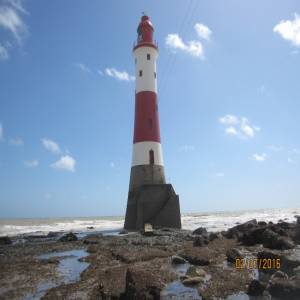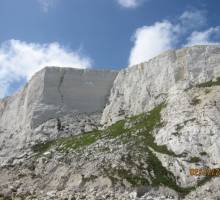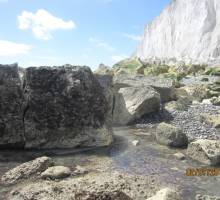
A Trip To The Lighthouse
A TRIP TO THE LIGHT HOUSE - by Boatshed Brighton's intrepid broker, Dan King
One of the most iconic images of Eastbourne is the red and white-striped lighthouse at the base of Beachy Head. It sits on a ledge some distance from the cliffs where rock falls cannot reach it. It was built in 1902 at a cost of £20,814 The red bands were painted in 1951, they were originally black and white. It replaced the Belle Tout light house on top of the cliffs. This was never the success hoped for as it was often shrouded in fog. Incidentally Belle Tout has nothing to do with the French. Bael was a Celtic word for war god and toot a Saxon word for look-out.
I have sailed past the light house in Squeezebox on numerous occasions and harbored a wish to step on it one day. You can’t do this in a yacht - there are many underwater obstructions and fast currents around it.
This weekend it was spring tides when the moon and sun are aligned with the Earth so that their gravitational effects are reinforced. This causes exceptionally high and low tides.
So I thought I would try and walk onto the light house. Timing is crucial because there is a wide shelf just below sea level that the incoming tides soon cover. The shelf is caused by erosion of the cliffs, which in ancient times extended over two miles further out than where they are now.In fact it is because of the rocky offshore shelf between Newhaven and Eastbourne that so many ships have been wrecked here, hence the light house.The small museum at Birling Gap features contemporary photographs of some of the wrecks.
I parked my car just round the corner from Bede’s School where the road up to Beachy Head turns sharply to the right. The time was 1.45pm, two and a half hours before low tide at 4.15pm. On the left of the cafe opposite is an access road. I followed this up the hill, then the road descended and opened up lovely views.
This picture shows the shelf appearing as the tide recedes. Keep following this road, which becomes a footpath near the cliff edge, then descend to the beach. Eventually you get to a set of steps at Cow Gap. There is a prominent sign saying consult tide tables! About 20 children with parents and teachers, all in hardhats (or the occasional substitute bike helmet) were there, busy hammering rocks looking for fossils. A charming scene.
The beach here is a mixture of sand, shingle, large pebbles and boulders, and fairly sheltered. A good place for a picnic on a sunny day.
I set off west along the shingle towards the light house. This is not visible from Cow Gap but after a half hour scrambling over rocks my objective appeared.
I grew very conscious of the steep rocks on one side and the sea on the other and looked for any escape route in the vent of a mishap, such as a sprained ankle or concussion. Not surprisingly mobile phone reception is poor to non-existent in the shadow of the cliffs. As the tide receded I remembered the law of 12ths. This is a rule of thumb for estimating tides. In the first hour after low tide the sea rises 1/12 of the tidal range, which in Eastbourne is about 20ft. In the second hour it rises 2/12, in the third 3/12. Then in the fourth hour 3/12, fifth hour 2/12 and sixth hour 1/12. So after the first hour of incoming tide you could be wading through uneven ground with strengthening currents.
Not safe at all.
With some relief I reached the lighthouse a good half hour before low tide. Now the going was easy. A pontoon led up to the base but then there were three large circular stepping stones to negotiate before reaching the steps. I think these were made of oil drums filled with concrete. Water was still swirling underneath and it was windy because the cliffs accelerate the winds as they round Beachy Head!
I climbed the steps grateful for the handrail and rested on the base platform. The actual front door is reached by grab rails. The wire at the top is for communications because the light house is unmanned these days. There is a gantry for raising goods.Time was getting on so I set off back. Red balls hang on the comms line from the light house to the cliff top. Apparently low flying aircraft have cut the comms line in the past!
The cracks in the cliff face are very noticeable and it is only matter of time before a massive chunk falls off. Now it was low tide and I stepped over innumerable rock pools on my way back.
As mentioned there have been hundreds of shipwrecks alongthis coast, but it was not until 1832 the Belle Tout light house was built. In the 18th century a local clergyman called Darby was so worried about it that he enlarged a cliff cave and put lights in it to warn ships. He even built a state to the cliff top using a hammer and chisel. For many years this light was known as Parson Darby’s Hole. On the way back I tried to find it but all I saw in this cave was a rusty car engine, probably from a quad bike. A different type of fossil! All along the beach was stuff washed ashore or fallen from the cliff top. Car tyres with ropes on them are fenders from large fishing boats.
Finally back to Cow Gap and safety where the young manicminers were just leaving. Up the hill I took these pictures of Eastbourne whichshows the large tidal range we have here. Then home to a cold beer and a bath!
I heartily recommend this excursion, just make sure you start two hours or more before low spring tide.






